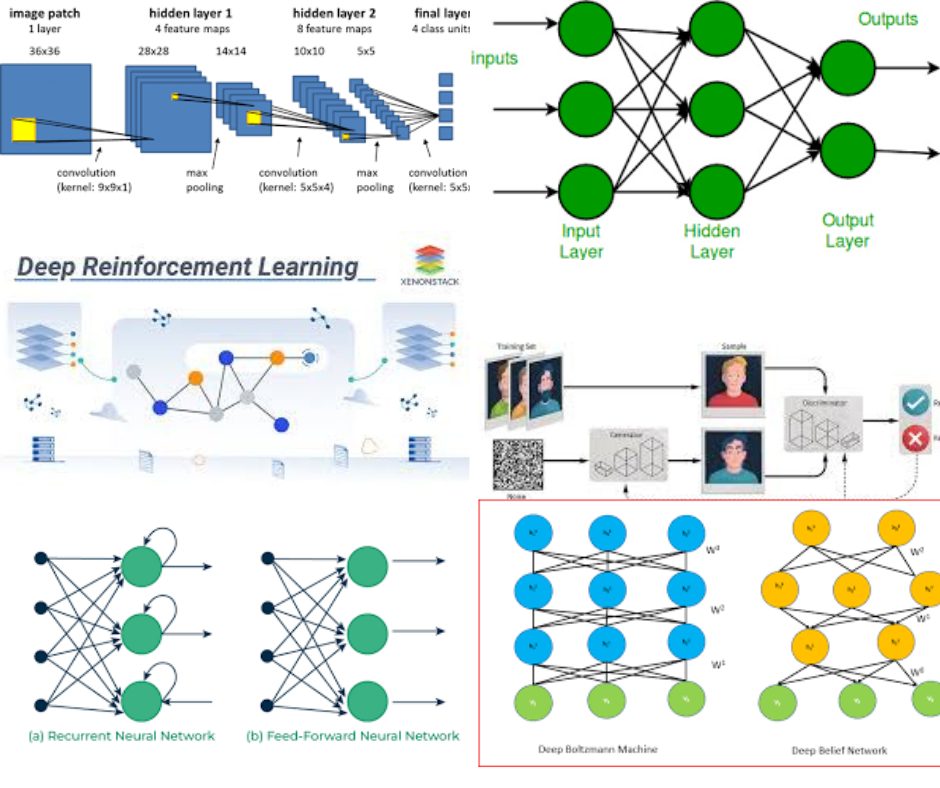Deep learning is a specialized subset of machine learning, which itself is a division of Artificial Intelligence (AI). It plays a crucial role in the development of intelligent computer programs that can perform a variety of tasks. At its core, deep learning aims to enable computers to understand and process data in a manner that mimics the workings of the human brain. This approach allows deep learning models to identify intricate patterns across different types of data—such as images, text, audio, and more—leading to insightful conclusions and accurate predictions.
Types of Deep Learning
Deep learning encompasses several model architectures and techniques, each designed for specific types of tasks. Some of the prominent types include the following:
1. Convolutional Neural Networks (CNNs)
Convolutional Neural Networks excel in image recognition and processing tasks. Their architecture is particularly effective at identifying objects and patterns in images, even in cases where the images are obscured or distorted. CNNs achieve this through the use of convolutional layers that capture spatial hierarchies and features.
– Example: CNNs are widely used in facial recognition systems, enabling machines to accurately identify and verify individuals based on facial features.
2. Recurrent Neural Networks (RNNs)
RNNs are designed for handling sequential data, making them ideal for natural language processing and speech recognition. They are particularly adept at understanding context and relationships within sequences, which is essential for tasks that involve time-dependent data.
– Example: RNNs are frequently applied in language translation services and speech recognition applications, helping convert spoken language into text and translating phrases between different languages.
3. Deep Reinforcement Learning (DRL)
Deep reinforcement learning combines deep learning techniques with reinforcement learning principles, allowing agents to learn optimal behaviors through interaction with their environments. This approach is particularly valuable in complex decision-making scenarios, such as robotics and gaming.
– Example: Autonomous vehicles, including self-driving cars, rely on deep reinforcement learning to navigate and make real-time decisions based on environmental inputs.

4. Generative Adversarial Networks (GANs)
GANs consist of two competing neural networks—a generator and a discriminator—that work together to create realistic synthetic data. This framework has gained popularity in tasks that require the generation of multimedia content.
– Example: GANs are used to generate high-quality photographs of human faces, create realistic images for video games, perform image-to-image translation, and facilitate text-to-image generation.
5. Multilayer Perceptrons (MLPs)
MLPs are a foundational type of feedforward artificial neural network. They consist of multiple layers of neurons, where each layer fully connects to the next. MLPs are proficient in recognizing patterns and learning relationships between both linear and non-linear data.
– Example: MLPs can be applied in complex data calculations and predictive analysis, offering insights into various domains, such as finance and marketing.
6. Other Types of Deep Learning
The field of deep learning also includes several other architectures and techniques, such as:
– Deep Belief Networks (DBNs): Used for unsupervised learning tasks.
– Transformers: Highly effective in natural language processing and tasks requiring attention mechanisms.
– Neural Radiance Fields (NeRF): Employed in view synthesis and 3D modeling.
– De-noising Autoencoder (DAE): Used to recover original data from noisy observations.
– Long Short-Term Memory (LSTM): A type of RNN that is adept at learning long-term dependencies in sequential data.
– Radial Basis Function Networks (RBFNs): Useful for function approximation and time series prediction.
– Self-Organizing Maps (SOMs): Employed for clustering and visualization tasks.
– Restricted Boltzmann Machines (RBMs): Utilized in collaborative filtering and dimensionality reduction.
– Autoencoders: Applied in unsupervised learning, specifically in tasks related to feature learning and data compression.
Deep learning is a diverse and rapidly evolving field that harnesses various neural network architectures to solve complex problems across multiple domains, pushing the boundaries of what machines can achieve in data processing and understanding.
You should seriously consider employing deep learning techniques when your specific task involves handling large, complex datasets that traditional machine learning algorithms struggle to manage effectively. Below is an in-depth analysis of scenarios where deep learning proves to be the optimal choice:
Appropriate Scenarios for Using Deep Learning:
1. Availability of Extensive Data
Deep learning models, particularly neural networks, thrive in environments where they have access to vast amounts of data. The abundance of training data allows these models to learn intricate patterns and representations.
For example, if you have millions of images for a computer vision task, a significant number of audio files for voice recognition, or extensive text documents for natural language processing, deep learning can harness this wealth of information to achieve superior performance.
2. Complexity of Unstructured Data
Deep learning excels at managing and analyzing unstructured data, which does not fit neatly into traditional database structures. Its architecture is particularly well-suited for tasks that involve raw, unprocessed data:
Images → For applications such as image classification and object detection, Convolutional Neural Networks (CNNs) are typically employed.
Audio/Speech → In the realm of audio processing, deep learning facilitates breakthroughs in speech recognition and music analysis through Recurrent Neural Networks (RNNs) and modern Transformers.
Text → Natural language processing tasks, such as translation and summarization, greatly benefit from advanced Transformer models like GPT and BERT, which are designed to understand and generate human language.
Video → For video analysis, deep learning techniques are used for action recognition and video captioning, demonstrating its versatility across multiple types of media.
3. Necessity of Automatic Feature Learning
One of the standout advantages of deep learning is its ability to automatically extract and learn relevant features from raw data without the need for meticulous manual feature engineering, which is often required in traditional machine learning.
4. Critical Need for High Accuracy
In high-stakes environments such as medical diagnosis, autonomous driving, or fraud detection, achieving high levels of accuracy is paramount. Deep learning’s capacity to model and learn from complex data patterns makes it ideal for these applications.
5. Importance of Scalability and Real-time Performance
When implemented correctly—particularly through the use of powerful GPUs or TPUs—deep learning models can not only scale effectively but also deliver real-time inference. This operational efficiency is a significant advantage in many applications.
Situations Where Deep Learning Should Be Avoided:
1. Limited Data Availability
When working with small datasets, deep learning models are prone to overfitting, which can lead to poorer performance compared to simpler models. In such cases, it is often more beneficial to rely on traditional algorithms like decision trees, support vector machines, or logistic regression, which excel in these scenarios.
2. Prioritizing Interpretability
Deep learning models are generally regarded as “black boxes,” making it challenging to understand how they arrive at their decisions. If your application necessitates a high degree of explainability or regulatory transparency—for instance, in finance or healthcare contexts—traditional machine learning models may be a better fit.
3. Limited Computing Resources
Training deep neural networks can be extremely resource-intensive, requiring both powerful GPUs or TPUs and substantial computational power. For those with restricted access to such resources, deep learning may not be feasible.
4. Need for Rapid Prototyping
If you’re in the early stages of a project and require quick iterations and testing, classical machine learning models offer a distinct advantage. They tend to be faster to train, tune, and deploy, making them more suitable for early-stage prototypes or proofs of concept.
In summary, while deep learning holds transformative potential for many applications, it is essential to carefully evaluate its appropriateness against your project’s specific requirements and constraints.



